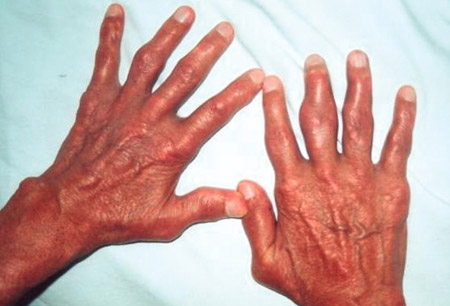Resumen
Definición
Anamnesis y examen
Principales factores de diagnóstico
- presencia de factores de riesgo
- hombres de >40 años
- uso de medicamentos que inducen a la gota
- consumo de carne, marisco o alcohol
- antecedentes de afección clínica con alta tasa de recambio celular
- dolor intenso de inicio rápido
- rigidez de las articulaciones
- distribución en las articulaciones del pie
- pocas articulaciones afectadas
- inflamación y derrame articular
- sensibilidad a la palpación
- tofos
Otros factores de diagnóstico
- eritema y temperatura elevada
- antecedentes familiares de gota
Factores de riesgo
- edad avanzada
- sexo masculino
- estado menopáusico
- consumo de carne, mariscos y alcohol
- uso de diuréticos
- uso de ciclosporina o tacrolimus
- uso de pirazinamida
- uso de aspirina
- susceptibilidad genética
- alta tasa de recambio celular
- obesidad
- adiposidad y resistencia a la insulina
- insulina exógena
- hipertensión
- insuficiencia renal
- diabetes mellitus
- hiperlipidemia
- antecedentes familiares de gota
Pruebas diagnósticas
Primeras pruebas diagnósticas para solicitar
- artrocentesis con análisis del líquido sinovial
Pruebas diagnósticas que deben considerarse
- nivel de ácido úrico en el suero
- ultrasonido
- tomografía computarizada de energía dual (DECT)
- radiografía de las articulaciones afectadas
Algoritmo de tratamiento
gota aguda
gota recurrente: 2-3 semanas después del episodio agudo
Colaboradores
Autores
Fadi Badlissi, MD, MSc

Assistant Professor
Harvard Medical School
Attending Physician
Director of the Musculoskeletal Medicine Unit
Department of Orthopedics & Division of Rheumatology
Beth Israel Deaconess Medical Center
Boston
MA
Divulgaciones
FB has received an honorarium as an advisory board member for Horizon Pharmaceuticals.
Revisores por pares
H. Ralph Schumacher, Jr., MD
Professor of Medicine
VA Medical Center
Philadelphia
PA
Divulgaciones
HRS has been a consultant for a number of pharmaceutical companies that produce drugs that can be used for the treatment of gout. Some companies have supplied HRS with funding. HRS is an author of a number of references cited in this topic.
Ade Adebajo, MD
Associate Director of Teaching and Honorary Senior Lecturer in Rheumatology
Academic Rheumatology Group
Faculty of Medicine
University of Sheffield
Sheffield
UK
Divulgaciones
AA declares that he has no competing interests.
Martin Underwood, MBBS
Professor of Primary Care Research
Warwick Medical School
Coventry
UK
Divulgaciones
MU declares that he has no competing interests.
Agradecimiento de los revisores por pares
Los temas de BMJ Best Practice se actualizan de forma continua de acuerdo con los desarrollos en la evidencia y en las guías. Los revisores por pares listados aquí han revisado el contenido al menos una vez durante la historia del tema.
Divulgaciones
Las afiliaciones y divulgaciones de los revisores por pares se refieren al momento de la revisión.
Referencias
Artículos principales
National Institute for Health and Care Excellence. Gout: diagnosis and management. Jun 2022 [internet publication].Texto completo
FitzGerald JD, Dalbeth N, Mikuls T, et al. 2020 American College of Rheumatology guideline for the management of gout. Arthritis Care Res (Hoboken). 2020 Jun;72(6):744-60. Resumen
Qaseem A, Harris RP, Forciea MA, et al; Clinical Guidelines Committee of the American College of Physicians. Management of acute and recurrent gout: a clinical practice guideline from the American College of Physicians. Ann Intern Med. 2017 Jan 3;166(1):58-68.Texto completo Resumen
Artículos de referencia
Una lista completa de las fuentes a las que se hace referencia en este tema está disponible para los usuarios con acceso a todo BMJ Best Practice.

Diferenciales
- Pseudogota (enfermedad por depósito de pirofosfato cálcico)
- Artritis séptica
- Traumatismo
Más DiferencialesGuías de práctica clínica
- Gout: diagnosis and management
- Treatment of gout
Más Guías de práctica clínicaFolletos para el paciente
Gout
Más Folletos para el pacienteVideos
Demostración animada de aspiración e inyección de la rodilla
Demostración animada de aspiración e inyección del hombro
Más vídeosInicie sesión o suscríbase para acceder a todo el BMJ Best Practice
El uso de este contenido está sujeto a nuestra cláusula de exención de responsabilidad